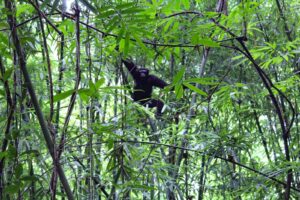Hoolock Gibbons, the only ape species found in India, are present in significant numbers in the Garo Hills of Meghalaya, locally called Huro (Huleng or Hulu in Khasi). The Gibbons are part of the community and coexist in harmony with the people. Garo Hills is blessed with the presence of gibbons in almost every village. They are known to bring good omen-like fertility, good harvest and prosperity, and their absence is believed to bring bad omen-such as sickness or famine. It is thus forbidden to kill or harm their species and offence is imposed on whoever violates the law. This in a way, ensures conservation of the Huro, with rules and regulations different from one village to another.
Male gibbons are black in colour and the females are copper tan. According to the community members, when a gibbon gives birth to female gibbons, it leaves for other communities, leaving behind its young ones in its habitat. This is done to populate their species. Unlike most other primates, gibbons form long-term pairs and at times, are known to mate for life.
Gibbons have an interesting way of locomotion known as brachiation. For this purpose, they have long slender arms and hook-like paws to help them move swiftly through the trees. This makes them the fastest ape, enabling them to move about 34 miles per hour. They stay up in the trees all their lives and barely come to the ground. They feed on fruit trees such as litchis, papaya, oranges, or whichever fruits are in season.
Crystaline B Marak of Darechikgre community in West Garo Hills is a custodian farmer and traditional knowledge holder, who was quoted as saying, “Harming of gibbons is strictly prohibited in our community as we believe that their presence bring us good luck, and their absence bring bad omen, sickness and shame. So far, no one in our community has tried to harm them, and if outsiders come, we tell them. The gibbons come to us to eat fruits from our orchards, but they are not destructive unlike other wild animals such as monkeys or wild boars.”
Gibbons communicate by way of singing in high-pitched tones at sunrise, which resonate through the trees, signalling their presence. Their vocalisations are often referred to as songs because of the way they modulate their pitch. They sing alone and in duets as well as in groups
Decrease in the forest cover, accompanied with the diminishing number of fruit trees pose a grave threat to the gibbons that the Garos highly revere. Deprived of their natural habitat, the gibbons will have nowhere to go, giving rise to the fear of extinction. As per the beliefs pertaining to their presence, if gibbons are wiped out from our communities, one can only imagine the repercussions that come with it.




